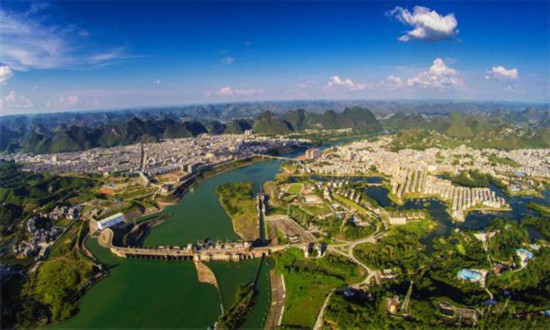Dahua Yao autonomous county

Dahua Yao autonomous county, Hechi, Guangxi Zhuang autonomous region. [Photo/gx.people.com.cn]
Established in October 1988, Dahua Yao autonomous county covers an area of 2,716 square kilometers and has a total population of 479,000 people, of which 26.51 percent is comprised of members of the Yao ethnic group.
Due to factors like location, resources, history, and culture, Dahua is famous for green food, ethnic customs, and natural landscapes.
During the 13th Five Year Plan period (2016-2020), the county has focused on the overall goal of building a well-off society in an all-around way. Dahua has made efforts in improving its level of urbanization, helping impoverished people relocate. It has also developed planting and breeding industries, as well as promoted the aquaculture and tourism industries in the three functional areas divided by the government according to geographical distribution, namely the urban area, the karst area, and the reservoir area.
It also strives to accelerate the development of modern characteristic agriculture and new industries, as well as develop the tourism and e-commerce logistics service industries.
In 2019, the county's regional GDP reached 7.18 billion yuan ($1.03 billion), with a year-on-year increase of 2 percent. Its fiscal revenue was 845 million yuan, a year-on-year increase of 22.5 percent. The added value of industries above designated scale was 1.95 billion yuan, a year-on-year increase of 0.2 percent. Its fixed asset investment reached 4.09 billion yuan, a year-on-year increase of 29 percent.
The total retail sales of consumer goods was 2.2 billion yuan, a year-on-year increase of 7 percent. The per capita disposable income of urban residents was 25,552 yuan, a year-on-year increase of 8.8 percent, and that of rural residents was 9,141 yuan, a year-on-year increase of 11.3 percent.
In 2019, a total of 2.39 billion yuan was invested in the relocation of 29,730 people living in mountainous areas, of which 28,566 were impoverished. A total of 409 poverty alleviation breeding farms have been put into use, helping 26,900 villagers increase their incomes. A total of 41,468 people from 30 poverty stricken villages were lifted out of poverty, and the incidence of poverty dropped to 4.28 percent.


